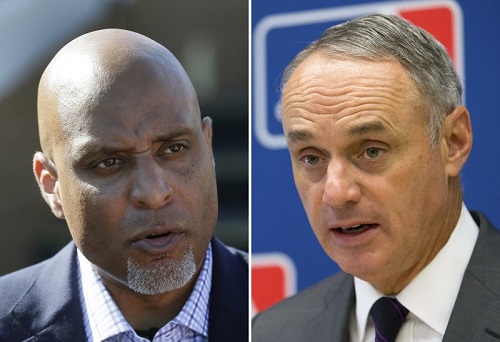When most baseball fans went to bed on Wednesday night, they did so with the comfort in knowing that an agreement had been reached between Major League Baseball and the Major League Baseball Players Association on a new five-year Collective Bargaining Agreement (CBA), thereby preventing an owners’ lockout and/or a players’ work stoppage, the last of which occurred 22 years ago in 1994.

MLBPA executive director Tony Clark and MLB commissioner Rob Manfred
(AP photos)
The agreement came a mere three hours before the existing CBA was due to expire at midnight (ET) on December 1, 2016. But while nearly all of the focus was on that looming deadline and on leaked reports (through various “sources”) regarding changes to the current qualifying offer system, and on the signing of international players, the one ‘report’ that somehow managed to slip under the radar was that the MLBPA had won its decade-and-a-half long battle to eliminate the winner of the annual All-Star Game from automatically securing home field advantage for that year’s World Series.
No big deal, you say?
If so, you’d be wrong.
Since its implementation after a 30-0 vote by MLB owners in January 2003 (after strong lobbying by then MLB commissioner Bud Selig), the American League has won 11 of the last 14 All-Star Games played under Selig’s ASG home field advantage rule (which was supposed to be a two year experiment), with the AL going on to win eight World Series titles in those 14 years [and we all snickered at that even-year San Francisco Giants nonsense]. At the time, we (collectively) were force-fed Selig’s belief that: “This energizes [the All-Star Game]. This gives them something to really play for,” Selig professed at the time. “People pay a lot of money to see that game. They deserve to see the same intensity they see all year long. Television people pay a lot of money for the game. It was not and should not be a meaningless exhibition game.”
Although Selig will probably go to his grave – hopefully not any time soon – believing that his ASG concept was what everybody wanted, the (approximate) 1,200 members of the enormously strong MLBPA (and nearly every baseball fan on the planet) obviously didn’t see it that way. As such, it came as a surprise to no one that the union voted to do away with Selig’s failed two-year experiment that lasted 14 years. What did come as a surprise however, is that news of rule change went unmentioned until Associated Press broke the news around midnight PT Wednesday night.
Another significant change in the new CBA is that the long-running 15-day disabled list is now a 10-day disabled list. And while this also may seem somewhat insignificant in the big scheme of things, it too is actually is a pretty big deal – especially during the stretch run late in the season when teams begin to seriously scrutinize their pending playoff rosters. It will also (hopefully) prevent teams from burying guys with relatively minor ailments on the bench instead of simply placing them on the DL to expedite their recovery.
The one decision that the players did not go for that was thought by many to be a slam dunk was increasing a team’s active (25-man) roster to 26 – a move that would have increased the total number of actual MLB players from 750 to 780. And though no reason as to why the union decided against this move was not mentioned as of this writing, we will undoubtedly soon learn of the MLBPA’s reasoning behind it, perhaps as early as later this morning.
The absolute bottom line is that the 2017 baseball season – and the four subsequent seasons – will now go on as originally scheduled. And why shouldn’t it, with MLB’s record-setting 2016 revenue of 10 billion dollars.
That’s 10 billion … with a B.




 December 1st, 2016 at 6:00 am
December 1st, 2016 at 6:00 am  by Ron Cervenka
by Ron Cervenka  Posted in
Posted in 

Best comment I’ve seen so far:
“While my efforts to eliminate pitchers from having to throw to 1B didnt pass, I’m proud of the PA & Owners for coming together on a new CBA!” ~ John Lester
“It was not and should not be a meaningless exhibition game.” Taken literally I’m in total agreement. It never was a meaningless exhibition game. It was, and will be again, a great show, an exhibition of the best against the best in MLB.
Back in the day nobody cared about the game situation when Maury got on 1b. Everybody wanted to see him go. Put the toughest pitcher and catcher to steal on out there made it even better.
I’m not a basketball fan, but I’ve always thought the NBA puts on the best ASG. It’s all about giving the fans what they want to see.
The DL change is good too. I’m wondering if they still have the concussion list (7-day). It seems to me they should just put them on the 10-day list.
I’m surprised the players didn’t go for the roster increase. I ‘spect we’ll hear more about that later. Over in the war zone they’re saying it tied to a reduction in Sept. call-ups.
IMHO, roster should be 29, with a 4 man “taxi squad”, and allowances to make changes day to day.
I’m happy to learn that the All Star game no longer gives home field advantage to the winner. Now we can just sit back and enjoy the game as we did in years passed.
Only question i have now that the Pennant winner with the best record gets HFA for WS, is what if both AL and NL Pennant winners have identical records at end of season?
Troublemaker! 😉
Not a bad question though.
Postseason record maybe?
They’ll probably use head to head if applicable.